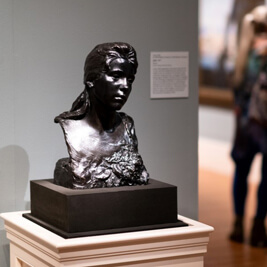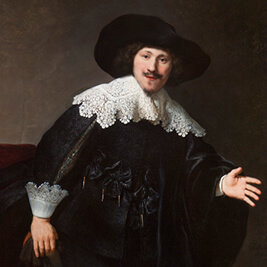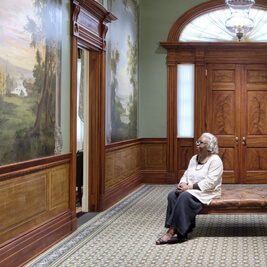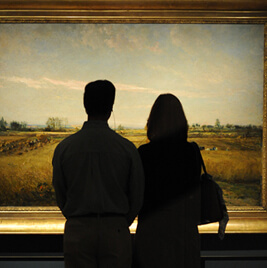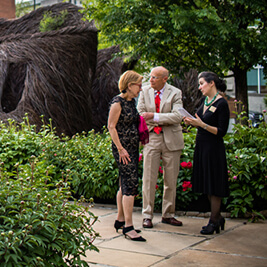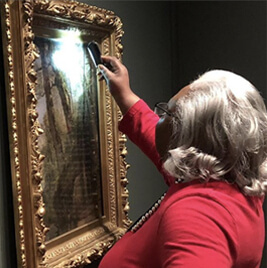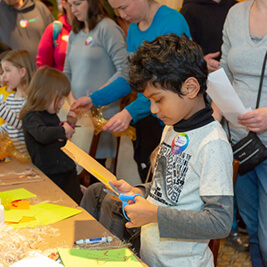- Do + See
- Dine + Host
- Give + Join
- Educate + Learn
Highlights from the Taft Collection | Summer 2020
Jean-Baptiste-Camille Corot, Memory of Riva
In 1834, Camille Corot spent a week in Riva del Garda, a scenic village at the northern tip of Lake Garda, near the Italian Alps. He made this painting more than thirty years later, referring to oil sketches he made during his time at the lake and relying upon his memory. Corot distilled the emotions he felt at Riva into a dreamy landscape, with a tree silhouetted against a pearly blue sky and the rosy sun glowing at the horizon beyond the placid lake. Describing how he created his late landscapes like this one, Corot said, “As for me, I paint feeling over feeling.”
TAKE A CLOSER LOOK
Have you ever visited a place so beautiful that you can’t stop thinking about it? What do you remember most vividly about the location? As time passes, specific details can become difficult to recall. Looking at this painting, what details do you think may have faded in Corot’s memory?
Robert S. Duncanson, Landscape Mural
Trees frame a vista across a rugged landscape. The sky glows orange and pink above a river cascading down from distant mountains. Four woodsmen gather around a campfire, smoke rising from its embers. Robert S. Duncanson painted this spectacular landscape, along with seven others, as part of a commission by Nicholas Longworth (1783–1863) to decorate the entry hall of his home, now the Taft Museum of Art. Likely inspired by the Ohio River Valley, the murals represent imagined landscapes rather than particular places. The murals launched Duncanson’s career: he went on to become the first African American artist to achieve international acclaim.
TAKE A CLOSER LOOK
Duncanson arranged his landscape compositions so that the objects closest to us are large and very detailed while the objects furthest away from us are smaller and simpler. Using less detail and smaller sizes creates an illusion of depth—the landscape seems to continue into the distance even though everything is painted on the same wall. Look at the trees in this mural. How do they change as they get closer to the horizon line (where the sky and land meet)?
Jean-Baptiste Carnay and Alexandre-Jean Noël, Snuffbox with Views of a Portuguese Villa
This stunning gold snuffbox, made by Jean-Baptiste Carnay, was intendedto store snuff, a smokeless tobacco widely popular in Europe during the 18th century. It is fitted with eight intricately painted miniatures by Alexandre-Jean Noël. These panels depict multiple views of a villa near Lisbon, Portugal, which the merchant Gerard de Vismes (1725/1726–1798) purchased in 1767. Vismes lavishly decorated his Neoclassical palace and added waterfalls to the ground’s elaborate gardens. A visitor recalled that “at each step my eyes see objects that surpass anything I could imagine and that leave me with no other feeling than pure admiration.”
TAKE A CLOSER LOOK
During this time, certain artists specialized in creating intricately detailed tiny paintings. Imagine the small brushes, the amount of time, and steady hand it would have taken to paint these beautiful images. Look at the different paintings on this snuffbox. What small details can you pick out?
Vase with Dragons
Two horned dragons encircle this vase, their twisting bodies emerging from the crashing waves. In Chinese culture, these creatures, often associated with water, symbolize power and strength. Artists and craftsmen depicted the four-clawed mang dragon, seen here, on objects made for or acquired by high-ranking officials and nobility. The delicate curves of this vase showcase the pale green celadon glaze covering its body. Collectors and scholars hold green glazed-celadon vessels in high esteem because of the color’s association with jade, a mineral valued since antiquity for its spiritual and medicinal powers, as well as its durability and purity.
TAKE A CLOSER LOOK
The maker of this vase carefully incised lines to create a composition of dragons and water that delicately pops off the surface. After the craftsman applied the single-color glaze and then fired the vessel, subtle variations of light and dark emerged in the crevices left by the carved designs. Where do you see the darkest shades of the celadon glaze? The lightest?
Pierre Reymond, Casket with the Triumph of Diana
During the Renaissance, as now, couples exchanged gifts. This casket, a luxury object commissioned as a wedding present for a bride, once held jewelry, cosmetics, hair combs, or sewing tools—all possible offerings integral to courtship. The depiction of three Roman goddesses further celebrates the theme of love: Juno symbolizes marriage and youthfulness, Venus represents beauty and desire, and Diana signifies chastity and childbirth. Pierre Reymond showed off his superb skill by delicately modeling the figures and animals. He created the images by building up and then slowly removing layers of white enamel from a nearly black initial layer. This technique, known as grisaille, resulted in subtle shades of gray.
TAKE A CLOSER LOOK
Animals were often associated with specific gods and goddesses and are used on this casket to help us identify the deity in each panel. The dove represents Venus, the deer stands for Diana and the peacock for Juno (not pictured, on reverse side of the casket). If you were to have an animal represent you, which would you choose? What quality of that animal represents you?

